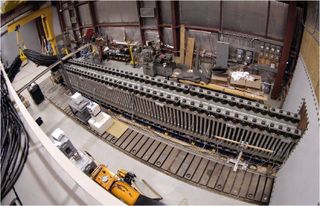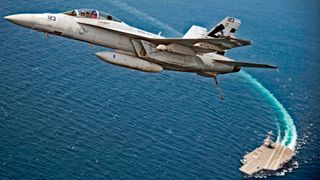In 1974, the late Princeton University professor and space visionary Gerard O’Neill proposed using electromagnetic railguns to deliver payloads from the Moon.
O’Neill proposed using “mass drivers” based on a coil gun design to accelerate a non-magnetic object. One application for mass drivers was to launch lunar-derived materials into lunar orbit for manufacturing in space. O’Neill also worked on mass drivers at MIT, working with colleague Henry H. Kolm and a group of far-sighted student volunteers to produce their first mass driver prototype. Supported by grants from the Space Studies Institute, later prototypes improved the mass driver concept.
That was five decades ago. Fast forward to the present and ask yourself this question: What does the US Navy’s nuclear aircraft carrier Gerald R. Ford have to do with the moon?
Future lunar economy
Late last year, General Atomics Electromagnetic Systems submitted a final report to the Air Force Office of Scientific Research (AFOSR). The report was titled “Electromagnetic Lunar Launch for Resource Exploitation to Enhance National Security and Economic Growth.”
The author of this assessment is Robert Peterkin, operations manager of the organization’s office in Albuquerque, New Mexico.
The 30-page document stresses that the moon is rich in useful resources, including silicon, titanium, aluminum and iron, and that the prospect of exploiting lunar water is also great.
“A not-too-distant lunar economy will use these lunar resources to supply, repair, and refuel spacecraft in lunar orbit at lower costs than would be possible by supplying terrestrial resources from Earth’s deep gravitational field,” the report said.
Machines, structures, systems
Electromagnetic launches of materials from the lunar surface, the report continues, can be much more efficient than conventional rocket launches based on chemical fuels imported from Earth to the moon.
The assessment provides recommendations for advancing the technology needed to transport mined and processed lunar material into cislunar space to support a range of future space missions.
A particularly important aspect of developing a lunar economy, the report says, is the reliable, cost-effective and safe removal of mass from the lunar surface. “Undoubtedly, the first spiral of a development cycle for a lunar ecosystem will rely on the supply of machinery, structures and support systems from Earth.”

Superior choice
Using lunar resources to repair and resupply cislunar spacecraft will require advances in several technologies, including a reliable method for transporting material from the lunar surface, Peterkin told Space.com.
A modern electromagnetic launch vehicle would be a better choice for this task, Peterkin said, because it could use abundant solar energy as its primary power source without having to import chemical rocket fuel from Earth.
“The U.S. government should fund further development of the existing electromagnetic aircraft launch system, which currently operates reliably on the U.S. Navy’s nuclear aircraft carrier Gerald R. Ford,” Peterkin emphasizes.
This carrier-based hardware is manufactured by General Atomics and is called Electromagnetic Aircraft Launch System (EMALS).

Way there
Peterkin said that advancing this Earth-based technology would require achieving higher speeds at lower masses – and he demonstrated work that puts the lunar launch capability into fast-forward mode.
The lightning-fast speed required to launch pound-class payloads from lunar terrain into low circular orbit around the Moon is 3,758 miles per hour (1.68 kilometers per second).
“To prove feasibility, we need to show that this approach can achieve lunar orbital velocity,” Peterkin said, “for at least 100 launches without replacing launch vehicle components.”
As the report to the Air Force Office of Scientific Research states, “While it is important to envision a mature state in which a self-sustaining ecosystem on the Moon extracts, processes, and transports materials into lunar space to build, supply, and maintain cislunar spacecraft and space settlements, it is equally important to find a way to achieve this goal.”